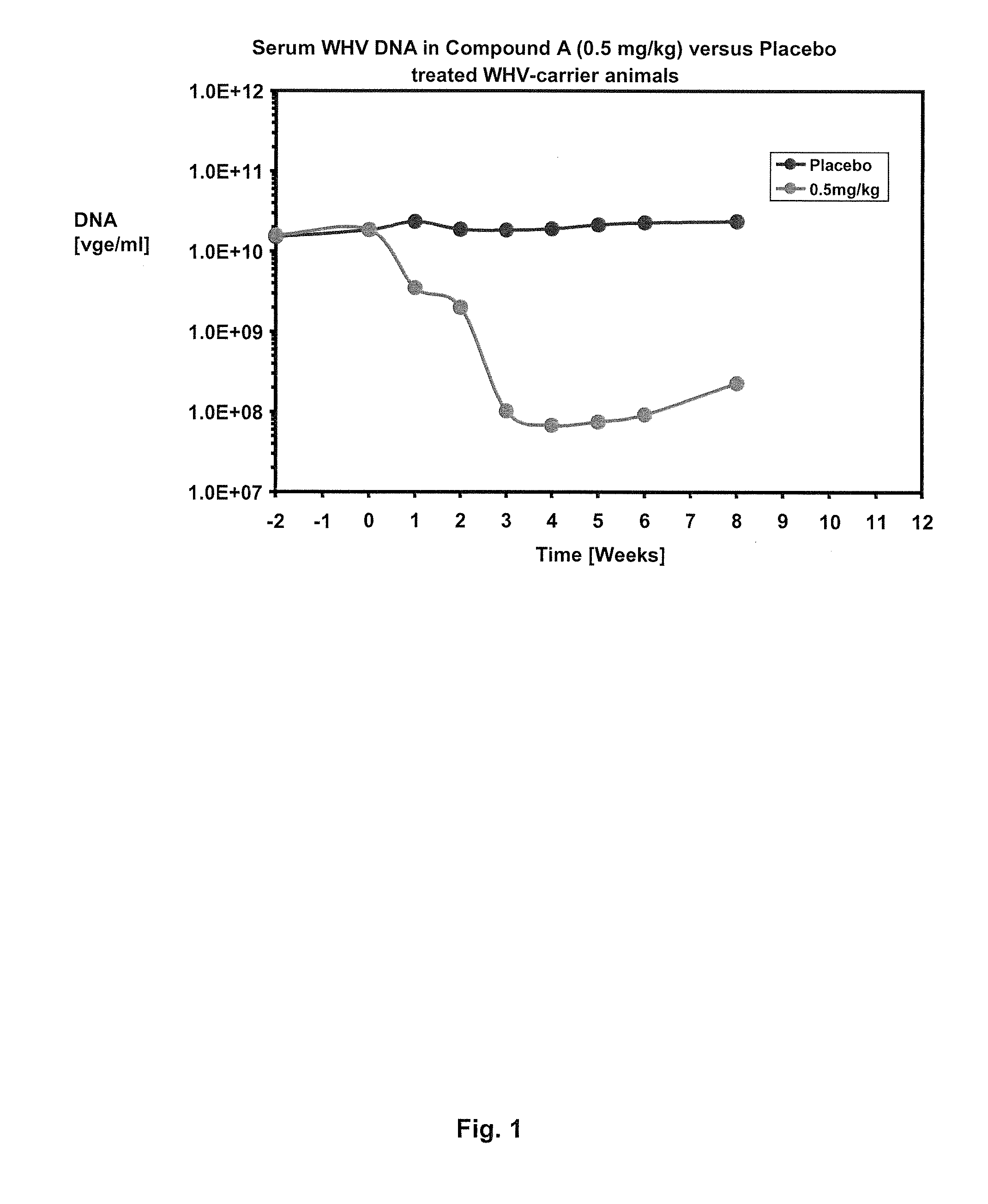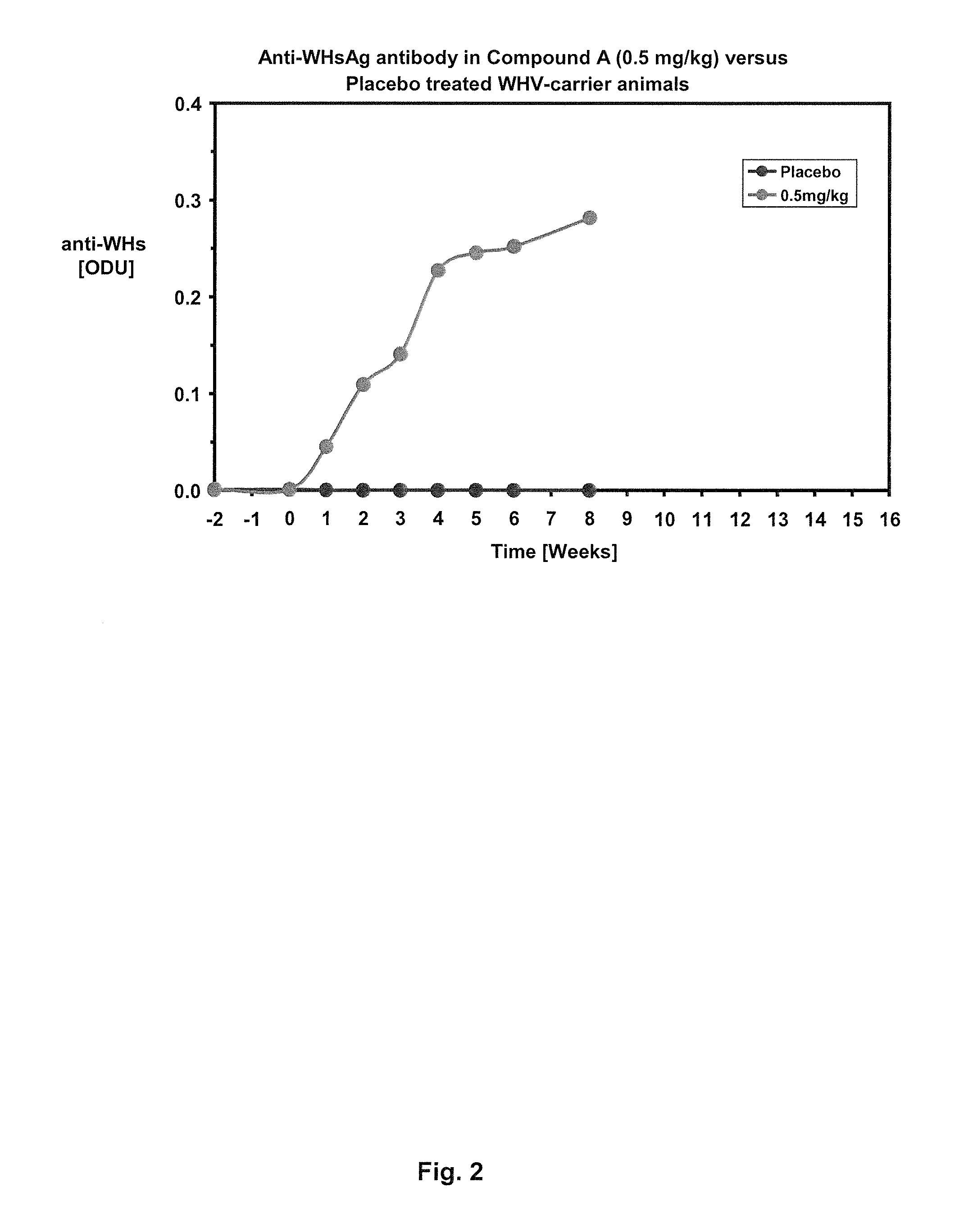Methods of treating hbv and hcv infection
a technology of hbv and hcv infection, applied in the field of purine derivatives and pharmaceutical compositions, can solve the problems of increasing the incidence of hepatocellular carcinoma or liver cancer, inability to clear the virus from the body, and infection may be entirely asymptomatic and unrecognized, so as to reduce the viral load, reduce the rate of progression, and improve the effect of symptoms
- Summary
- Abstract
- Description
- Claims
- Application Information
AI Technical Summary
Benefits of technology
Problems solved by technology
Method used
Image
Examples
example 1
Synthesis of Compound A
[0121]
Compound 1
[0122]To a solution of TsOH—H2O (505 mg) in EtOAc (750 ml) in a water bath, was gradually added 2,6-dichloropurine (49.75 g). The temperature was then raised to 50° C. To this solution, 3,4-dihydro-2H-pyran (31.5 mL) was added dropwise at ˜1.0 ml / min over 30 min through a slow addition pressure equalizing funnel. After addition was done, the reaction was stirred for another 30 min, and then allowed to cool to ambient temperature. The reaction was quenched with ice-cold water (˜300 mL) and then 3% w / v aq. NH3 was added (10 mL) to the rapidly stirred mixture. The organic phase was collected, washed with ice-cold water (2×250 ml), brine (100mL), then dried (Na2SO4), filtered, and concentrated down. The residue was diluted with heptane (500 mL) and heated to 100° C. in a water bath with a reflux condenser and the top of condenser open to air. When most of the material was dissolved, the flask was allowed to cool in a water bath to ambient temperatu...
example 2
Induction of Cytokines by Compound A in Human Peripheral Blood Mononuclear Cells (PBMCs) in Vitro
[0132]Frozen human PBMCs were thawed and used to seed the wells of 96 well plates (7.5×105cells / well in 190 μL / well culture medium (CM)). The cells were incubated for 1 hour at 37° C. at a 5% CO2. Ten microliters of CM containing Compound A was added to each well except for the control wells which received 10 μL CM that did not contain Compound A. The concentrations of Compound A that were tested were 0.1 μM, 0.01 μM, and 0.001 μM. The plates were incubated at 37° C., 5% CO2, for 24 hours, then centrifuged at 1200 rpm for 10 minutes. After centrifugation the supernatant was collected and stored at −80° C. The supernatant was assayed using Luminex and Upstate multi-plex kits for the presence of various cytokines.
[0133]The concentrations of the cytokines, in pg / mL, are shown in Table 1. Compound A stimulated the production of a range of cytokines in human PBMCs in vitro.
TABLE 1CompoundIL-A...
example 3
Induction of Interferon Alpha by Compound A in Cynomolqus Monkeys
[0134]A single dose of Compound A was administered orally to cynomolgus monkeys (3 or more animals per dose group) and serum was collected at 4 hours and 8 hours after dosing. Serum samples were analyzed for levels of interferon-alpha by ELISA. Prior to dosing, serum interferon-alpha levels were near or below the level of detection in each animal. The limit of quantitation (LOQ) for IFN-a based on cynomolgus monkey IFN-a standard was 625 pg / mL. Table 2 shows the average interferon alpha levels induced by Compound A.
TABLE 2Average peak serumCompound A DoseInterferon-alpha levels (pg / ml)(mg / kg)(Mean ± standard deviation)2.5772923 ± 2815290.0542741 ± 292230.0226148 ± 138730.0057829 ± 9192Predose719 ± 871
[0135]Additionally, multiple doses of Compound A were administered to Cynomolgus monkeys, and the concentrations of interferon alpha were measured.
[0136]Compound A was dosed orally once per day to Cynomolgus monkeys (3 ani...
PUM
| Property | Measurement | Unit |
|---|---|---|
| Time | aaaaa | aaaaa |
| Time | aaaaa | aaaaa |
| Time | aaaaa | aaaaa |
Abstract
Description
Claims
Application Information
 Login to View More
Login to View More - R&D
- Intellectual Property
- Life Sciences
- Materials
- Tech Scout
- Unparalleled Data Quality
- Higher Quality Content
- 60% Fewer Hallucinations
Browse by: Latest US Patents, China's latest patents, Technical Efficacy Thesaurus, Application Domain, Technology Topic, Popular Technical Reports.
© 2025 PatSnap. All rights reserved.Legal|Privacy policy|Modern Slavery Act Transparency Statement|Sitemap|About US| Contact US: help@patsnap.com



